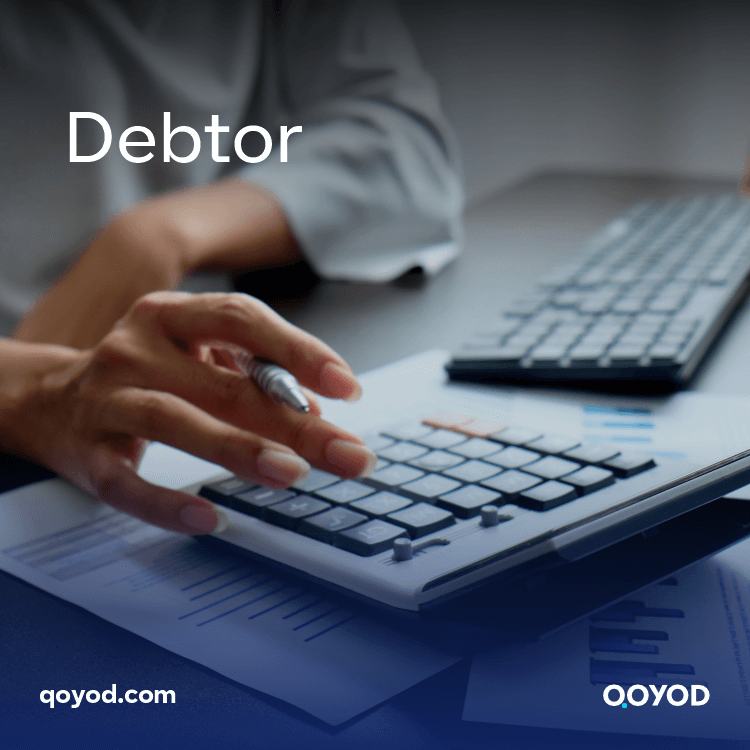In the world of business and finance, the concept of debtor plays a crucial role in organizing financial relationships and determining paths to success or challenge. The word debtor carries great weight beyond its mere linguistic meaning, as it carries with it financial responsibilities. In this article, we will discover the concept of the debtor, its types, and the different forms of debt in which there is a relationship between the debtor and the creditor. Let’s go together on an exciting journey to discover the secrets and importance of the concept of debtor in the world of business and finance.
Who is the debtor?
A debtor in economics is a person or entity that owes a sum of money or a certain value to another person or entity, known as a creditor. That is, the debtor is the party who owes the debt or has an has an obligation to pay the amount owed to the creditor according to the terms and conditions agreed upon in the contract. Financial contract or agreement. Debts can be between individuals, companies, or governments.
Types of debtors
Debtors are classified into different types that differ according to the nature of the financial obligations and debts that the debtor undertakes to pay to the creditor. Here is a detailed explanation of some types of debtors in the following points:
1-Individual debtor
A single debtor refers to individuals who have personal debts, such as car loans, mortgages, or credit cards. These debts can also include personal loans and medical debt.
2: Commercial debtor
A trade debtor refers to companies or businesses that borrow capital to invest in their business or day-to-day operations. These debts can include business loans and business lines of credit.
3: Government debtor
Government debtors refer to central or local governments, and their debts typically include government bonds and sovereign debt issued by the central government to finance government expenditures or public projects.
4: Guarantor debtor
A guarantor debtor is an individual or entity who is responsible for paying a debt owed if the original debtor is unable to pay. Guarantees usually include personal guarantees, such as bank guarantees and bill guarantees.
Types of debt
The types of debts taken on by any debtor vary depending on the nature of the debt and the sources on which it relies. In general, types of debt include the following:
1-Bank account loan
It refers to a loan that is provided by banks or other financial institutions to individuals or companies through their bank accounts. Any debtor uses this type of loan to meet personal or investment needs, and the loan amount and terms depend on the credit history and financial assessment of the beneficiary. If a person borrows money from the bank, the person is the debtor, and the bank is the creditor. Conversely, if a person puts money in the bank, the bank is the debtor and the person is the creditor.
2-Commercial loan
A business loan is a term commonly used as an accounting term that refers to a loan made by banks or financial institutions to companies or businesses to finance their business activities, such as purchasing new equipment or expanding their business. The terms and repayment period for the business loan debtor can be flexible and depend on the risk assessment and the debtor’s ability to repay.
3: Legal court debt
Refers to the amounts that a specific debtor (individual or company) must pay based on a judicial decision issued by the court. This may be due to legal issues related to compensation, damages, or other legal settlements.
4: personal loan
This loan is made to individuals (individual debtors) to meet their personal needs, such as improving a home, covering an emergency expense, or paying off other debts. The loan terms and repayment period vary based on the bank’s policy and the borrower’s credit assessment.
5: Real estate debt
This debt relates to loans used by a debtor to purchase or finance real estate, such as apartments, houses, and land. Mortgages are security for the loan, as the bank can seize the property if the loan is not repaid properly.
6: Credit card debt
This debt includes amounts spent using credit cards and must be paid based on the payment terms and interest accrued. These debts include everyday purchases and personal expenses that were paid by card.
The difference between a creditor and a debtor
Many people get confused about the meaning of debtor and creditor, so get to know them in the following table:
| Debtor | Creditor | |
| the difference | The debtor is a person or entity that owes an amount or a financial obligation to the other party (the creditor) and undertakes to pay the full amount owed to the creditor. | A creditor is a person or entity that has financial claims from the other party (the debtor) and expects to recover these claims in full. |
What does a credit balance mean?
A credit balance is the amount a person or entity owns (debtor) from the other party (creditor). The credit balance is considered a recording of the money that a person or entity must pay to the other party, and it is recorded as a balance in his account.
What is the concept of default?
Default in the context of creditor and debtor refers to the failure of a debtor to comply with its obligations to the creditor according to the contracted terms. Default can be the result of the inability to pay an installment on time, failure to comply with the terms of a contract or financial agreement, or the debtor’s neglect of his obligations.
The debtor’s failure to pay the debt is not considered a crime except in certain cases, such as the bankruptcy of the bank. But if the debtor fails to repay the debt, he has breached the contract with the creditor, so default can lead to legal consequences, such as prosecutions or debt collection by legal force.
What does separation clearance from the bank mean?
Separation Clearance from the bank in the context of indebtedness refers to the full and final payment of debts owed to the bank, which leads to the termination of any existing financial relationship between the customer and the bank (debtor and creditor).
Who is a credit and who is a debt in accounting?
The difference between debit and credit in accounting is different. In the context of accounting, debit is known as the right side of the budget account or ledger, where the financial values that are entered, spent, or calculated as a due amount are recorded. On the other hand, the credit is known as the left side of the account, where the financial values that are paid to the account are recorded or calculated as an amount due to be paid to the debtor. Ultimately, the sum of debits and credits in any account must be equal.
Achieve success for your company with the Qoyod system.
The Qoyod system represents an important development in the field of accounting and money management, as it allows access to financial data and account management from anywhere and at any time due to its cloud nature. It is the easiest accounting program that you can use in your company, and it provides you with a professional set of accounting services approved by the Zakat, Tax, and Customs Authority in the Kingdom of Saudi Arabia.
The Qoyod accounting system provides the debtor notice feature, which is the document that is sent to the vendor and makes him a debtor to the facility and is considered proof by the facility that it has a right that must be taken from the vendor. Qoyod also provides the feature of returning a product to the vendor easily and recovering the value of the product, while also providing the feature of adding your own terms, conditions, and notes and the feature of uploading a special attachment to the invoice, such as the basic image of the invoice (to keep it electronically and avoid loss and damage on paper).
Among the options that you can do regarding notifying the debtor in Qoyod are the following:
View: To view the debit note,.
Print: To print the debit note.
Download PDF: Download the debtor’s notice in PDF format.
Allocating a debit note: It is allocated to invoices due to the vendor (unpaid) to reduce the facility’s entitlement to the vendor and return the goods.
Refund: refunding money from the vendor in cash or on account.
Delete: Delete the debit note if the debit note or refund from the vendor has not been assigned.
Conclusion
The concept of a debtor appears to constitute an essential part of financial and business relations, as the debtor bears the responsibility of adhering to his financial obligations and ensuring the payment of debts owed to the creditor. Your understanding of the role of the debtor and the rights of the creditor contributes to building balanced and sustainable financial relationships, which enhance trust between you and the parties dealing with you and contribute to enhancing economic growth and financial stability in your facility.
Feel free to subscribe to the Qoyod accounting system today and enjoy all its services for free for a 14-day trial period without the need for a credit card. You can cancel your subscription or upgrade to a paid subscription at the best and most convenient prices at any time you wish.
Join our inspiring community! Subscribe to our LinkedIn page and Twitter to be the first to know about the latest articles and updates. An opportunity for learning and development in the world of accounting and finance. Don’t miss out, join us today!




